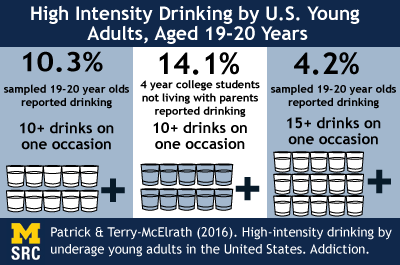April 18, 2017
Patrick and Terry-McElrath Provide New Insight into High-Intensity Drinking Behaviors in Young Adults
 Together with her SRC colleague Yvonne Terry-McElrath, SRC Research Associate Professor Megan Patrick recently published an article in Addiction entitled 'High-Intensity Drinking by Underage Young Adults in the United States.' This article addresses important gaps in knowledge with regard to both frequency of and trends in high-intensity drinking ( consuming 10+ or even 15+ drinks in a row at one occasion) , binge drinking, and sustained intoxication during the transition out of high school. The article presents descriptive and multivariate analyses of longitudinal data from the Monitoring the Future (MTF) study to understand changes in these behaviors over the course of one to two years after 12th grade; nine different cohorts from the MTF (first measured in 2005-2013 and followed up in 2006-2014) were ultimately analyzed in the study.
Together with her SRC colleague Yvonne Terry-McElrath, SRC Research Associate Professor Megan Patrick recently published an article in Addiction entitled 'High-Intensity Drinking by Underage Young Adults in the United States.' This article addresses important gaps in knowledge with regard to both frequency of and trends in high-intensity drinking ( consuming 10+ or even 15+ drinks in a row at one occasion) , binge drinking, and sustained intoxication during the transition out of high school. The article presents descriptive and multivariate analyses of longitudinal data from the Monitoring the Future (MTF) study to understand changes in these behaviors over the course of one to two years after 12th grade; nine different cohorts from the MTF (first measured in 2005-2013 and followed up in 2006-2014) were ultimately analyzed in the study.
The article reports fairly high prevalence of binge drinking, high-intensity drinking, and sustained intoxication among this population, and shows that the overall prevalence of binge and HID increases during the transition out of high school. However, the article also shows that within individuals, these behaviors generally tend to decrease during the transition out of high school. In addition, the authors report that the prevalence of binge drinking and HID has in fact decreased across the nine MTF cohorts, and that the vast majority (roughly 3/4) of this population does not tend to engage in these behaviors. Four-year college students who were not living with their parents were found to be at highest risk of engaging in these behaviors when controlling for a variety of other socio-demographic covariates, suggesting that intervention strategies should particularly target this subgroup of young adults. This study was novel not only in its use of longitudinal MTF data, but also in its consideration of the living situations of young adults and how that moderates the relationships of various socio-demographic factors with high-risk drinking behaviors.
In light of these results, the article calls for early intervention to prevent high-risk drinking behaviors during the high school years, and also intervention for those exhibiting high-risk drinking behaviors during the high school years to aid the transition out of high school. Interestingly, the authors report that the prevalence of having 15+ drinks in a row at some point in the last two weeks has remained rare but stable across these cohorts. The absence of a decrease in this behavior over time for this population does introduce a need for possible interventions that could decrease what is undoubtedly an extremely high-risk behavior.
In sum, this article makes effective use of several cohorts of MTF data to answer important public health questions, and points to several opportunities for evidence-based interventions in a population that is very vulnerable to alcohol abuse and dependence.